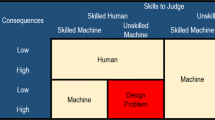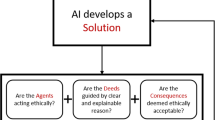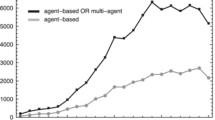Abstract
Awareness is a concept that has been frequently studied in the context of Computer Supported Cooperative Work. However, other fields of computer science can benefit from this concept. Recent research in the multi-agent systems field has highlighted the relevance of complex interaction models such as multi-party communication and context awareness for simulation and adaptive systems. In this article, we present a generic interaction model that enables to use these different models in a standardized way. Emerging as a first-order abstraction, the environment, in the sense of a common medium for the agents, is a suitable paradigm to support the agents’ awareness. We present an operational model, called Environment as Active Support of Interaction, to take into account all the agents that can be interested in a communication. This model is then extended for the regulation of multiagent systems interactions. Priority policies are given to manage the rules governing the context (un-)awareness of the agents. We also present a new AUML connector to create protocols that take into account the agent awareness to implement proactive behaviour, and several communication scenarios are proposed to show practical applications of this model.







Similar content being viewed by others
Notes
Such as \(=\), \(>\) or \(\subset \), more details on symbolic data operators can be found in Bock and Diday (2000).
Formally, \(f_c\) is a horde, i.e. a conjunction of assertions containing tests on several entities descriptions (Diday 1991).
The Foundation for Intelligent Physical Agents (FIPA) is the main standards organization for agents and multi-agent systems: http://www.fipa.org.
References
Balbo, F., & Pinson, S. (2010). Using intelligent agents for transportation regulation support system design. Transportation Research Part C: Emerging Technologies, 18(1), 140–156.
Benini, M., Cindio, F. D., & Sonnante, L. (2005). Virtuose, a virtual community open source engine for integrating civic networks and digital cities. In Digital Cities III, Lecture Notes in Computer Science (Vol. 3081, pp. 217–232). Springer, Berlin
Bock, H., & Diday, E. (2000). Analysis of symbolic data, exploratory methods for extracting statistical information from complex data. In Studies in classification, data analysis, and knowledge organisation (Vol. 15). Berlin: Springer .
Branigan, H. (2006). Perspectives on multi-party dialogue. Research on Language & Computation, 4(2–3), 153–177.
Busetta, P., Donà, A., & Nori, M. (2002). Channeled multicast for group communications. In: AAMAS ’02: proceedings of the first international joint conference on autonomous agents and multi-agent systems (pp. 1280–1287). New York: ACM Press.
Camarinha-Matos, L. M., & Afsarmanesh, H. (2002). Design of a virtual community infrastructure for elderly care. In: PRO-VE ’02: Proceedings of the IFIP TC5/WG5.5 third working conference on infrastructures for virtual enterprises, The Netherlands: Kluwer, B.V. Deventer.
Carriero, N., Gelernter, D., & Leichter, J. (1986). Distributed data structures in linda. In: POPL’86: Proceedings of the 13th ACM SIGACT-SIGPLAN symposium on Principles of programming languages (pp. 236–242). ACM Press.
Davis, R., & Smith, R. G. (1988). Negotiation as a metaphor for distributed problem solving. Distributed Artificial Intelligence, 20(1), 333–356.
Diday, E. (1991). From data analysis to uncertainty knowledge analysis. In Symbolic and quantitative approaches to uncertainty (pp. 153–160).
Drury, J., Scholtz, J., & Yanco, H. (2003). Awareness in human-robot interactions. In IEEE international conference on systems, man and cybernetics 2003. (Vol. 1, pp. 912–918).
Dugdale, J., Pavard, J., & Soubie, B. (2000). A pragmatic development of a computer simulation of an emergency call center. In Designing cooperative systems: the use of theories and models (pp. 241–256). Amsterdam: IOS Press.
Endsley, M. (1988). Design and evaluation for situation awareness enhancement. In Human factors society, annual meeting, 32nd (pp. 97–101). CA: Anaheim.
Esteva, M., Rodriguez-Aguilar, J., Rosell, B., & Arcos, J. (2004). Ameli: An agent-based middleware for electronic institutions. In: Proceedings of the 3rd international joint conference on autonomous agents and multi-agent systems (AAMAS 2004) (pp. 236–243). New York: ACM Press.
Gouaïch, A., Michel, F., & Guiraud, Y. (2005). Mic*: A deployment environment for autonomous agents. In: Weyns, D., Parunak, H. V. D., & Michel, F. (eds.) Proceedings of environment for multi-agent systems, workshop held at the third AAMAS conference (Vol. 3374, pp. 109–126) Springer, LNAI.
Gutnik, G., & Kaminka, G. A. (2006). Representing conversations for scalable overhearing. Journal of Artificial Intelligence Research, 25, 349–387.
Hattori, F., Ohguro, T., Yokoo, M., Matsubara, S., & Yoshida, S. (1999). Socialware: Multiagent systems for supporting network communities. Communications of the ACM, 42(3), 55. doi:10.1145/295685.295701.
Heath, C., Svensson, M. S., Hindmarsh, J., Luff, P., & vom Lehn, D., (2002). Configuring awareness. Computer Supported Cooperative Work, 11(3), 317–347. doi:10.1023/A:1021247413718.
Julien, C., & Roman, G. C. (2006). Egospaces: Facilitating rapid development of context-aware mobile applications. IEEE Transactions on Software Engineering, 32(5), 281–298. doi:10.1109/TSE.2006.47.
Kaminka, G., Pynadath, C., & Tambe, M. (2002). Monitoring teams by overhearing: A multi-agent plan-recognition approach. Journal of Artificial Intelligence Research, 17, 83–135.
Kumar, S., Huber, M. J., McGee, D., Cohen, P. R., & Levesque, H. J. (2000). Semantics of agent communication languages for group interaction. In Proceedings of the Seventeenth National Conference on Artificial Intelligence (pp. 42–47). AAAI Press/The MIT Press.
Legras, F., & Tessier, C. (2004). Lotto: Group formation by overhearing in large teams. In Advances in Agent Communication, LNAI (Vol. 2922, pp. 254–270) Berlin: Springer.
Markopoulos, P., De Ruyter, B., & MacKay, W. (2009). Awareness systems: Advances in theory, methodology and design. Berlin: Springer.
Odell, J., Parunak, H. V. D., & Bauer, B. (2000). Extending uml for agents. In Proceedings of the agent-oriented information systems workshop at the 17th conference on artificial intelligence.
Omicini, A., & Zambonelli, F. (1999). Tuple centres for the coordination of internet agents. In: SAC’99: Proceedings of the 1999 ACM symposium on Applied computing (pp. 183–190). New York: ACM Press. doi: 10.1145/298151.298231.
Omicini, A., Ricci, A., & Viroli, M. (2008). Artifacts in the A&A meta-model for multi-agent systems. Autonomous Agents and Multi-Agent Systems, 17(3), 432–456.
Platon, E., Sabouret, N., & Honiden, S. (2004). T-compound: An agent-specific design pattern and its environment. In Proceeding of the third international workshop on Agent Oriented Methodologies at OOPSLA (pp 63–74).
Platon, E., Sabouret, N., & Honiden, S. (2005). Overhearing and direct interactions: Point of view of an active environment. Proceedings of environment for multi-agent systems, workshop held at the fourth AAMAS conference, Springer Verlag, LNAI (vol. 3830, pp. 121–138).
Platon, E., Sabouret, N., & Honiden, S. (2007). Tag interactions in multiagent systems: Environment support. In Weyns, D., Parunak, H. V. D., Michel, F. (eds.), Proceedings of Environment for Multi-Agent Systems, Workshop held at the fifth AAMAS conference, LNAI (Vol. 4389, pp. 106–123) Berlin: Springer.
Ricci, A., Omicini, A., Viroli, M., Gardelli, L., & Oliva, E. (2007). Cognitive stigmergy: Towards a framework based on agents and artifacts. In: Weyns, D., Parunak, H. V. D., Michel, F. (eds.). Proceedings of Environment for multi-agent systems, workshop held at the fifth AAMAS conference, LNAI, (Vol. 4389, pp. 124–140). Berlin: Springer.
Saunier, J., & Balbo, F. (2007). An environment to support multi-party communications in multi-agent systems. Multi-agent systems and applications V, 5th international central and eastern European conference on multi-agent systems, CEEMAS 2007 (pp. 52–61). Leipzig, Germany: Springer.
Saunier, J., & Balbo, F. (2009). Regulated multi-party communications and context awareness through the environment. International Journal on Multi-agent and Grid Systems, 5(1), 75–91.
Saunier, J., Balbo, F., & Badeig, F. (2007). Environment as active support of interaction. In: Weyns, D., Parunak, H. V. D., Michel, F. (eds.) Proceedings of environment for multi-agent systems, workshop held at the fifth AAMAS conference, LNAI (vol. 4389, pp. 87–105). Berlin: Springer.
Sycara, K., & Wong, H. (2000). A taxonomy of middle-agents for the internet. In ICMAS ’00: Proceedings of the fourth international conference on multiagent systems (ICMAS-2000), IEEE computer society pp. 465–466.
Traum, D., & Rickel, J. (2002). Embodied agents for multi-party dialogue in immersive virtual worlds. In AAMAS’02: Proceedings of the first international joint conference on autonomous agents and multiagent systems (pp. 766–773) New York: ACM Press.
Tummolini, L., Castelfranchi, C., Ricci, A., Viroli, M., & Omicini, A. (2004). ”Exhibitionists” and ”voyeurs” do it better: A shared environment approach for flexible coordination with tacit messages. In: Weyns, D., Parunak, H. V. D., Michel, F. (eds.), Proceedings of environment for multi-agent systems, workshop held at the third AAMAS conference, LNAI, (Vol. 3374, pp. 215–231) Berlin: Springer.
van den Besselaar, P., & Beckers, D. (2005). The life and death of the great amsterdam digital city. In Digital Cities III, Lecture Notes in Computer Science (Vol. 3081, pp. 66–96) Berlin: Springer.
Vertegaal, R., Velichkovsky, B., & Van Der Veer, G. (1997). Catching the eye: Management of joint attention in cooperative work. SIGCHI Bulletin, 29, 87–92.
Warren, R. (1999). Auditory perception. A new analysis and synthesis. Cambridge: Cambridge University Press.
Weyns, D., Parunak, H. V. D., Michel, F., Holvoet, T., & Ferber, J. (2004). Environments for multiagent systems, state-of-the-art and research challenges. In: Weyns, D., Parunak, H. V. D., Michel, F. (eds.), Proceedings of Environment for Multi-Agent Systems, Workshop held at the third AAMAS conference, LNCS (Vol. 3374, pp. 2–52).
Weyns, D., Steegmans, E., & Holvoet, T. (2004). Towards active perception in situated multi-agent systems. Journal on Applied Artificial Intelligence, 18(9–10), 867–883.
Weyns, D., Omicini, A., & Odell, J. (2007). Environment as a first-class abstraction in multi-agent systems. Autonomous Agents and Multi-Agent Systems, 14(1), 5–30. Special issue on Environments for Multi-agent Systems.
Zheng, W., Serban, C., & Minsky, N. (2007). Establishing global properties of multi-agent systems via local laws. In: Weyns, D., Parunak, H. V. D., Michel, F. (eds.), Proceedings of Environment for multi-agent systems, workshop held at the fifth AAMAS conference, LNAI (Vol. 4389, pp. 170–183). Berlin: Springer.
Author information
Authors and Affiliations
Corresponding author
Rights and permissions
About this article
Cite this article
Saunier, J., Balbo, F. & Pinson, S. A Formal Model of Communication and Context Awareness in Multiagent Systems. J of Log Lang and Inf 23, 219–247 (2014). https://doi.org/10.1007/s10849-014-9198-8
Published:
Issue Date:
DOI: https://doi.org/10.1007/s10849-014-9198-8




